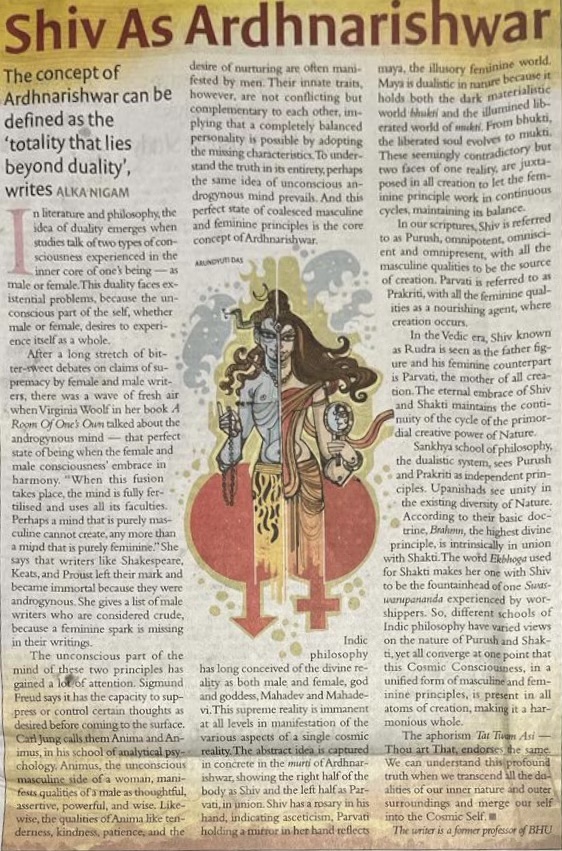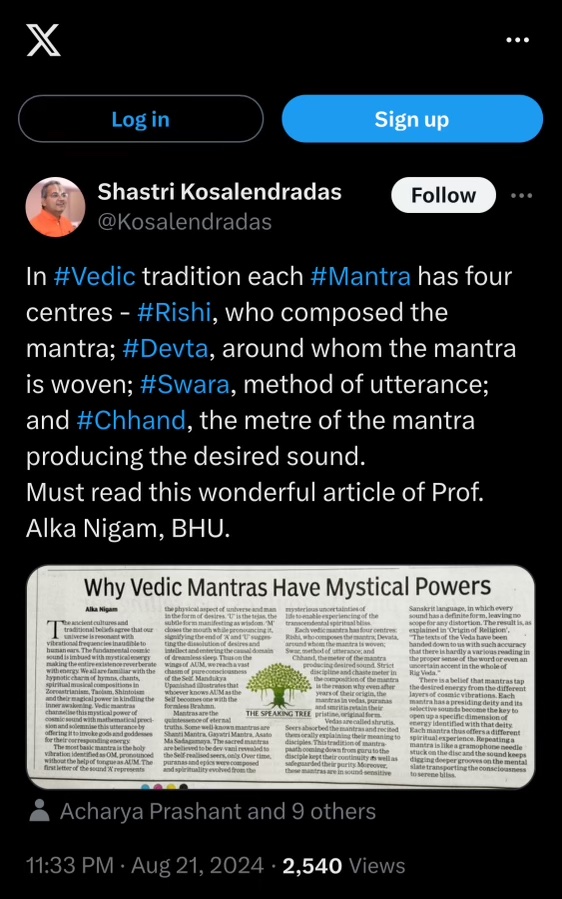Published at “The Speaking Tree”, The Times of India, July 8th 2023

Spiritually in nutshell the concept of Ardhnarishvar can be defined as the “Totality that lies beyond duality”. In Literature and philosophy, the idea of duality emerges when these studies talk of two types of consciousness experienced in the inner core of one’s being as male or female. This duality faces existential problems because the unconscious of self whether the male or the female, desires to experience itself as a whole. After a long chaotic stretch of bitter –sweet debates on claiming the supremacy by female and male writers there was a wave of fresh air when Virginia Woolf in her book A Room of One’s Own talked about androgynous mind—that perfect state of being when the female and male consciousness embrace in harmony . “…when this fusion takes place the mind is fully fertilized and uses all its faculties. Perhaps a mind that is purely masculine cannot create, any more than a mind that is purely feminine.” She says writers like Shakespeare, Lamb. Cowper, Keats, Proust left their mark and became immortal because they were androgynous. Milton, who had a dash too much of a male, came next to them. She gives a list of several male writers who are considered crude because a feminine spark is missing in their writings.
Philosophers give immense attention to the unconscious part of mind of these two principles. Freud says it has the capacity to suppress or control certain thoughts as desired before coming to the surface. Carl Jung names them as Anima and Animus in his school of analytical psychology. Animus, the unconscious masculine side of a woman, manifests qualities of a male as thoughtful, assertive, powerful, wise. Likewise, the qualities of Anima like tenderness, kindness, patience, desire of nurturing are often manifested by males. Their innate traits, however, are not conflicting but complementary to each other implying that a completely balanced personality is possible by adopting the missing characteristics. For the understanding of truth in its entirety perhaps the same idea of unconscious androgynous mind prevails.
And this perfect state of coalesced masculine and feminine principles is the core of the concept of Ardhnarishvar in Hindu philosophy. In the Hindu religious tradition from the beginning the divine reality is conceived of as both man and woman – God and Goddess or Mahadeva and Mahadevi. This supreme reality Is transcendent in its absolute but immanent at all levels in manifestation of the various aspects of a single cosmic reality. The abstract idea is captured in concrete in the idol of Ardhnarishvar showing the half right body -form of Shiva and the left body -form of Parvati in union. Shiva has rosary in hands indicating ascetism. Parvati holding a mirror in her hands reflects the illusory feminine world also known as Maya. Maya is dualistic in nature because it holds both the dark materialistic world “Bhukti” and the illumined liberated world of “Mukhti”. Mukhti is an evolved step onwards of Liberated soul from Bhukti. These seemingly contradictory but only two faces of one reality are juxtaposed in all creation to let the feminine principle work in continuous cycles maintaining its balance. In Hindu scriptures, Shiva is referred to as Purush- -Omnipotent, Omniscient and Omnipresent — with all the masculine qualities to be the source of creation and Parvati is referred to as Prakriti with all the feminine qualities as the nourishing agent where the creation occurs. In Vedic era Shiva known as Rudra is the father figure and the Feminine counterpart as Parvati, the mother of all creation. The eternal embrace of Shiva and Shakti keeps the continuity of cycle of the primordial creative power of Nature. Sankhya school as a dualistic system takes Purush and Prakriti as independent principles. The Upanishads see unity in the existing diversity of Nature. According to its basic doctrine the highest divine principle Brahmn is intrinsically in union with Shakti . The word Ekbhoga used for Shakti makes her one with Shiva to be one fountainhead of one swasvarupananda experienced by worshippers.
The gamut of the different views in different schools of Hinduism about the nature of the concept of Purusha and Shakti is wide. Yet all the diverse views converge into one strand that this Cosmic Consciousness in unified form of masculine and feminine principles is present in all the atoms of creation making it a harmonious whole .The aphorism TAT TWAM ASI endorses the same. We can understand this profound truth when we transcend all the dualities of our inner nature and outer surroundings and melt our self into the Cosmic Self.
ALKA NIGAM
Former Professor of BHU

Leave a Reply